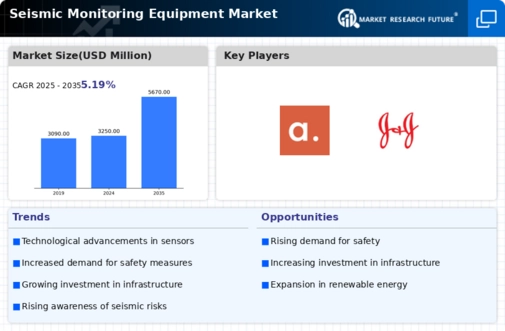Top Industry Leaders in the Seismic Monitoring Equipment Market

Top listed global companies in the Seismic Monitoring Equipment industry are:
Schlumberger
CGG
INOVA
Navigating the Tremors: A Look at the Competitive Landscape of the Seismic Monitoring Equipment Market
The global seismic monitoring equipment market represents a crucial segment in ensuring public safety and studying the Earth's crust. This dynamic space houses various players vying for a strong foothold, making it essential to understand their strategies, market share drivers, and emerging trends.
Key Players and their Strategies:
- Established Leaders: Renowned companies like Sercel and Guralp Systems leverage extensive product portfolios, brand recognition, and global reach to secure a significant market share. Sercel offers diverse equipment for various applications, while Guralp excels in high-precision seismic sensors.
- Regional Champions: Companies like Tianjin Branch of BGI (China) and I.D.E. GeoEquipment (Italy) dominate specific regions by tailoring solutions to local geographies, regulatory requirements, and infrastructure needs. Tianjin Branch of BGI caters to China's vast seismic monitoring needs, while I.D.E. GeoEquipment focuses on solutions suited for the complex geological conditions in Europe.
- Agile Innovators: Startups like Fibrisense and Seismic Cloud disrupt the market with novel approaches. Fibrisense develops innovative fiber-optic sensors offering high sensitivity and distributed sensing capabilities, while Seismic Cloud focuses on cloud-based data management and analysis platforms, improving data accessibility and collaboration.
Factors for Market Share Analysis:
- Product Portfolio Breadth and Depth: Offering a variety of equipment for diverse applications (land-based, marine, downhole) and diverse capabilities (seismic reflection, microseismic monitoring) caters to a wider customer base and expands market reach. Sercel exemplifies this with its diverse portfolio.
- Technological Innovation: Integrating advanced features like real-time data transmission, improved sensor sensitivity, and artificial intelligence-powered analytics enhances data quality, efficiency, and accuracy of seismic monitoring. Fibrisense's new sensor technology and Seismic Cloud's AI-powered analytics exemplify this trend.
- Cost-Effectiveness and ROI: Balancing advanced features with affordability is crucial, especially in resource-constrained regions. I.D.E. GeoEquipment focuses on cost-effective solutions for specific regional needs.
- Compliance and Data Security: Adhering to stringent regulations regarding data security, equipment reliability, and environmental sustainability is essential for market access and user trust. Guralp excels in this area with its robust and secure data acquisition systems.
Emerging Trends and Company Strategies:
- Focus on Sustainability: Utilizing eco-friendly materials in equipment and adopting energy-efficient operations aligns with growing environmental concerns. Companies are actively exploring ways to reduce the environmental footprint of their products and operations.
- Integration with Advanced Technologies: Integrating sensors with the Internet of Things (IoT) and cloud-based platforms facilitates real-time data transmission, remote monitoring, and improved data analysis capabilities. Seismic Cloud's cloud platform exemplifies this trend.
- Distributed Seismic Arrays: Deploying dense networks of low-cost sensors, often developed by startups like Fibrisense, provides broader geographical coverage and enhanced data resolution for detailed seismic monitoring, particularly in urban areas.
- Focus on Machine Learning and Artificial Intelligence: Utilizing AI for data analysis, anomaly detection, and automated decision-making processes streamlines workflows, improves earthquake prediction capabilities, and facilitates faster responses. Companies are actively exploring the potential of AI in this field.
Overall Competitive Scenario:
The seismic monitoring equipment market presents a dynamic landscape with established players facing challenges from regional specialists and innovative startups. Success hinges on offering diverse product portfolios, embracing technological advancements, prioritizing cost-effectiveness and sustainability, complying with regulations, and adapting to emerging trends like cloud integration, distributed networks, and AI-powered solutions. Companies demonstrating agility, a commitment to innovation and responsible practices, and a focus on user needs and regional considerations hold a strong position in navigating the competitive tremors of this market.
Industry Developments and Latest Updates
Schlumberger:
February 21, 2024: Announced the launch of a new seismic sensor technology with enhanced sensitivity and noise reduction capabilities, improving data quality and resolution for exploration and reservoir characterization. (Source: Press release)
CGG:
January 19, 2024: Featured in a Reuters article discussing the impact of rising material costs on the production of seismic monitoring equipment, potentially leading to price increases. (Source: Reuters News article )
INOVA:
February 14, 2024, Announced a strategic partnership with a leading technology company to develop next-generation fiber optic sensors for permanent downhole monitoring in oil and gas wells, offering enhanced data acquisition in challenging environments. (Source: Inovageo Press release)

